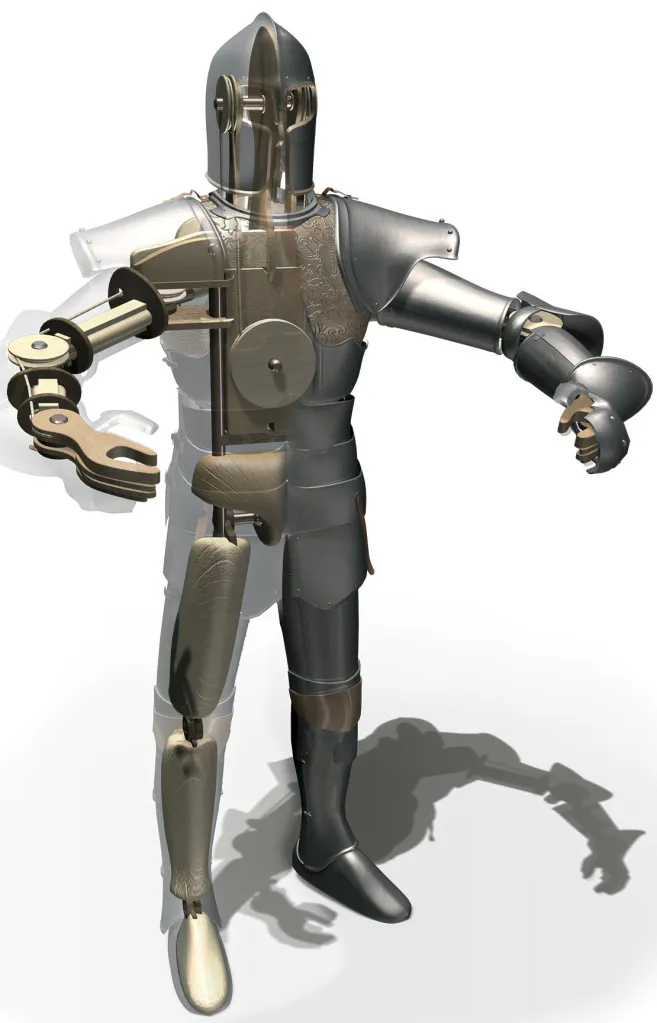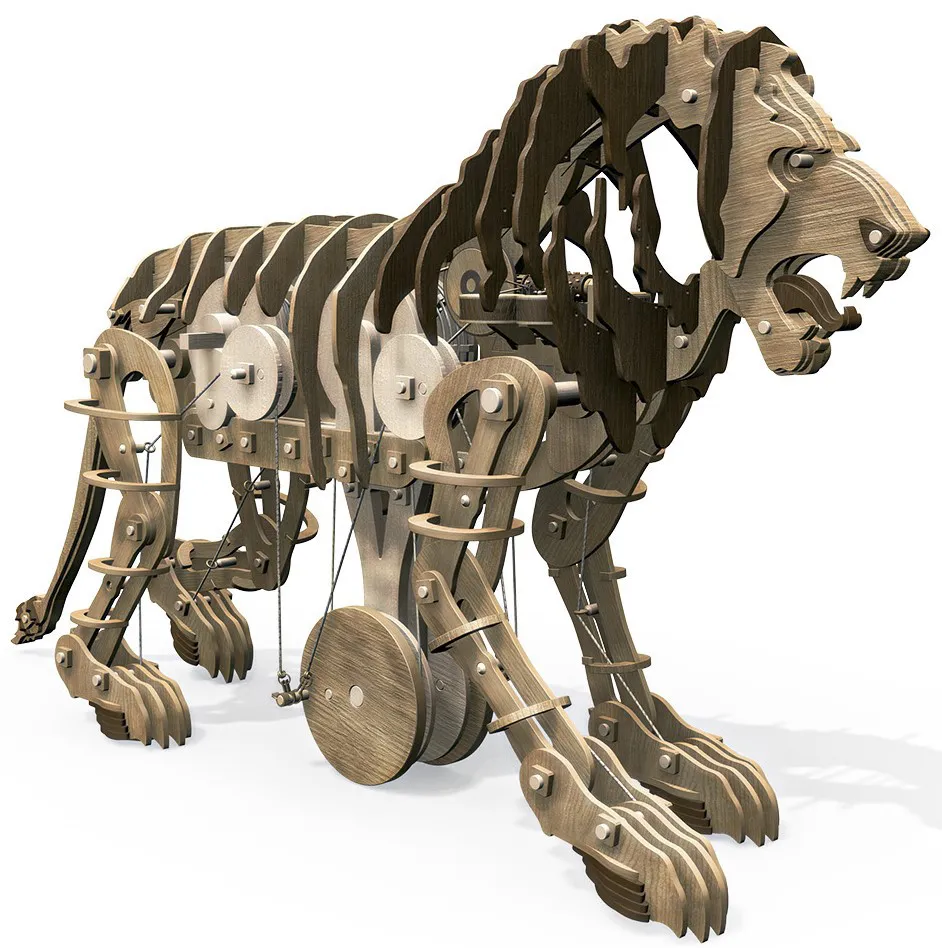Automatons were already being built in ancient times. The earliest creators include Ktesibios of Alexandria (3rd century BC) and Heron of Alexandria (1st century AD). Among the leading builders of automatons were: Ibn al Razzāz al-Jazarī, James Cox, Salomon de Caus, Heron of Alexandria, Pierre Jaquet-Droz, Athanasius Kircher, Friedrich Knaus, Henri Maillardet, Mical, Philo of Byzantium, Jacques Vaucanson, and Wolfgang von Kempelen. Ktesibios is regarded as the inventor of the water clock (clepsydra) and the pinned cylinder. These were used repeatedly in water organs. Heron was extraordinarily creative: reaction steam turbine (forerunner of the steam engine, also described as aeolipile), a musical machine, a theater automaton, and a pantograph (with toothed gear drive). Al-Jazarī is, e.g., known for his elephant clock. Mical built speaking heads. Salomon de Caus also constructed a musical machine.
Leonardo da Vinci (1452–1519) conceived, e.g., a self-propelled cart (1478, see Figure 1), a mechanical knight controlled by cables (1495, see Figure 2), and a mechanical lion (1515, see Figure 3) more than 500 years ago. Furthermore, he designed a mechanical bird, a mechanical dragonfly, a mechanical drum, a hydraulic clock, a derrick, and a flying machine. In thousands of drawings scattered over Italy, France, the U.K., and Spain, the polymath depicted a wide range of machines and instruments: shovel excavators (dredgers), paddlewheel boats, submarines, propellers, parachutes, printing presses, water-driven saws, grinding machines for concave mirrors, hodometers, clinometers, hygrometers, wind gauges, military machines (e.g., tanks), and more. Leonardo was familiar with structural elements and devices, such as ball bearings, belt transmissions, cams, chains, connecting rods, crank drives, flywheels, gear drives, inclined planes, levers, pendulums, pulleys (rope hoists), ratchet pawls, screws, spiral spring drives, and trammels.

Figure 1. The self-propelled cart. Model with spring drive of Leonardo da Vinci.
Some erroneously saw this as the precursor of today’s cars.
Credit: Museo Galileo, Florence.

Figure 2. The mechanical knight. The model of the medieval warrior is comprised of wood, metal, plastic, and glass.
Credit: Leonardo3 Museum, Milan.

Figure 3. Mechanical lion. The Italian research center Leonardo3 has produced a working wooden model of the lion with rope pulleys.
Credit: Leonardo3 Museum, Milan.
This post is the fourth in a series that presents selected technical marvels from the fields of computing technology, mathematics, astronomy, surveying, time measurement, looms, and automatons (automaton figures, chess-playing machines, musical automatons, automaton writers, drawing automatons, automaton clocks, picture clocks, globes, and historical robots). The examples are largely from the 15th to 20th centuries and do not claim to be exhaustive. In particular, artifacts are included for which high-quality illustrations are available. Most of the objects come from Europe, with a few from Africa, America, Asia, and Australia. The order is predominantly chronological. Famous names such as Archimedes, Hipparchus, Heron of Alexandria, Leonardo da Vinci, Galileo Galilei, John Napier, Jost Bürgi, Blaise Pascal, Gottfried Wilhelm Leibniz, and Charles Babbage are associated with these works. In some cases, however, the inventors are unknown (e.g. abacus, Antikythera Mechanism, yupana, quipu); see Technical Marvels – Communications of the ACM.
References
Bruderer, H.: Meilensteine der Rechentechnik, De Gruyter Oldenbourg, Berlin/Boston, 3. Auflage 2020, Band 1, https://doi.org/10.1515/9783110669664
Bruderer, H.: Meilensteine der Rechentechnik, De Gruyter Oldenbourg, Berlin/Boston, 3. Auflage 2020, Band 2, https://doi.org/10.1515/9783110669671
Bruderer, H.: Milestones in Analog and Digital Computing, Springer Nature Switzerland AG, Cham, 3rd edition 2020, 2 volumes, translated from the German by Dr John McMinn, https://doi.org/10.1007/978-3-030-40974-6
Campioni, R. (ed.): Leonardo artista delle macchine e cartografo, Giunti gruppo editoriale, Florence 1994
Capra, F.: The science of Leonardo, Doubleday Broadway Publishing Group, New York 2007
Cianchi, M.: Le macchine di Leonardo, Becocci editore, Florence 1981
Galluzzi, P. (ed.): Leonardo da Vinci, engineer and architect, The Montreal Museum of Fine Arts, Montreal 1987
Lisa, M., Taddei, M., and Zanon, E. (eds.): Leonardo dreidimensional, Chr. Belser AG, Stuttgart 2009
Nanni, R.: Leonardo and the artes mechanicae, Skira editore, Milan 2013
Rosheim, M.E.: Leonardo’s lost robots, Springer-Verlag, Berlin, Heidelberg 2006
Taddei, M.: Leonardo dreidimensional. Neue Roboter und Maschinen, Chr. Belser AG, Stuttgart 2008
Taddei, M. and Zanon, E. (eds.): Leonardos Maschinen. In der Werkstatt des genialen Erfinders, Theiss Verlag, Darmstadt 2017
Taddei, M., Zanon, E., and Laurenza, D.: Leonardo dreidimensional. Mit Computergrafik auf der Spur des genialen Erfinders, Chr. Belser AG, Stuttgart 2006
Taglialagamba, S.: Leonardo & l’ingegneria, CB edizioni, Poggio a Caiano (Prato) 2010
Taglialagamba, S.: Leonardo & engineering, CB edizioni, Poggio a Caiano (Prato), 2010
Taglialagamba, S.: Leonardo da Vinci. Automazioni e robotica/Automations and robotics, CB edizioni, Poggio a Caiano (Prato), 2010
Herbert Bruderer is a retired lecturer in the Department of Computer Science at ETH Zurich and a historian of technology. He recently was added to the Honor Roll of the IT History Society.




Join the Discussion (0)
Become a Member or Sign In to Post a Comment